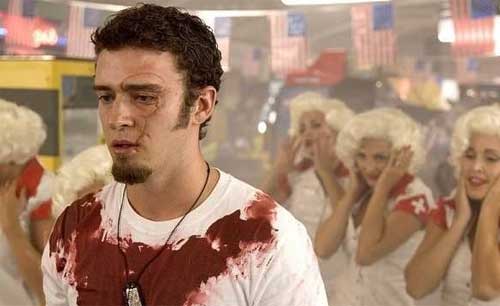Title: Paprika
Director: Satoshi Kon
Released: 2006
Starring: Megumi Hayashibara, Toru
Furuya, Toru Emori, Katsunosuke Hori, Akio Otsuka, Koichi Yamadera
Plot: In the near future, a device
called the “DC Mini” has been created which allows the user to view people’s dreams. Heading up
this treatment is Doctor Atsuko Chiba who also uses the machine to further her research
outside of the facility under her alter-ego Paprika. However when the
machine is stolen all hell looks set to break loose as the line between dreams
and reality becomes increasingly blurred.
Review: It is always a sense of sadness which accompanies
each of Satoshi Kon’s films I watch, especially when they equally serve as a reminder
of the seemingly unlimited creativity he processed which due to his untimely death from Cancer would ultimately total
four films while his fifth “Dreaming Machine” still lingers in production limbo
despite the efforts of the founder of Animation studio “Madhouse” Masao
Maruyama which have suffered due to lack of funding for the project. As his
final film before his death this film does however provide a suitable closing note
to an unquestionably impressive, if yet at the same time still underrated film
making resume which has in turn inspired the likes of Darren Aronofsky who
drew inspiration for “Black Swan” from “Perfect Blue” while this film in
particular would prove a key inspiration for Christopher Nolan’s “Inception” which
only becomes all the more clearer when you watch the film.
Originally intended to be the follow up to his debut
“Perfect Blue” it would however be delayed when original distribution
company Rex Entertainment went backrupt, leading Kon to make “Millennium
Actress” instead. Thankfully the wait would prove to be worthwhile as her Kon
is clearly working at the top of his ability as he combines dazzling visuals
with complex plotting, while at the same time further exploring the synergy of
dreams and reality a theme which run throughout most of his films as well as
his series “Paranoia Agent” but here he puts it up front and centre.
Opening with a blustering dash through the various dreams of
Detective Toshimi Konakawa (Otsuka) which play like a series of random movie
clips and see him not only engaging in a spot of Tarzan action but also taking
the lead in his own spy thriller before Kon suddenly snaps us back into reality
or atleast one of the many forms it takes in this world, with Kon quickly
following up this attention grabbing opening with the zany opening sequence
which see’s Chiba switching between her alter-ego Paprika and her real form
while Kon sprinkles even the supposed real world with fun surreal elements as
colourful adverts suddenly come to life as she passes them.
Even in the real world it is still one packed with
fascinating characters with certainly the most memorable having to be the
monstrously obese and childlike genius Tokita who created the DC Mini and who
when we first encounter him has wedged himself inside a lift. The dreamscape however is where Kon truly lets his
creativity shine with his centrepiece being a maniacal parade, comprised of
various colourful characters which rolls on like an unstoppable tide and only
continues to be added to as the dreamscape grows ever more out of control. Elsewhere
Chiba as Paprika is able to manipulate the dreamscape to her advantage, turning
herself into a fairy and even at one point taking on the form of Monkey (a
reference possibly lost on those not up to speed on their Asian mythology)
complete with staff and magic cloud! Of course the further she delves into the
dreamscape the more twisted it becomes especially the closer she gets to those
responsible for abusing the power the DC Mini provides the user with.
While the visuals might be exceptionally pretty to look at
they are truly heightened by the electro heavy soundtrack composed by long term
collaborator Susumu Hirasawa who once again pulls off something quite special,
while many such as the parade theme and opening theme are exceptionally catchy
while having that rare quality of working even when taken away from the film.
Unquestionably this is a film which requires more than one
watch especially when the plotting can at times come off perhaps slightly
unnecessarily complex in places, especially towards the end when the two worlds
become fully blurred leading to some certainly impressive sequences, especially
when you look at the level of detail in scenes like the parade, whose sheer
variety of characters may even have you hitting the pause button to take them
all in.
While this film like so many of his films might not be as
well known outside of anime fan circles, I can really only hope that this film
one day get exposed to a wider audience so that it will be rightfully refrenced
alongside the likes of “Akira” and “Ghost In The Shell” when it comes to naming
truly great anime, especially when it once again proves that animated films can
provide the same thrill and wonder as life action, while providing a fitting
end note (for now) to the remarkable career of Satoshi Kon

.jpg)




















